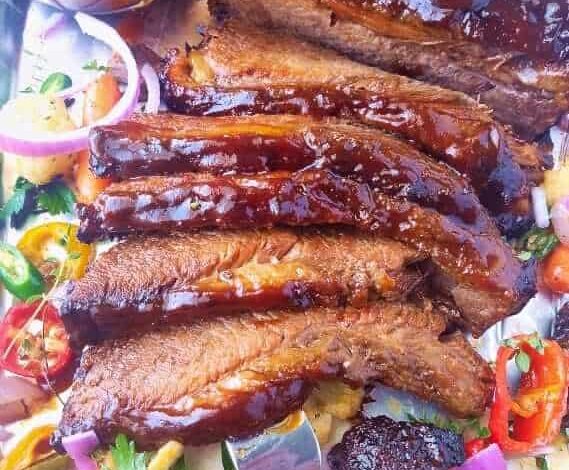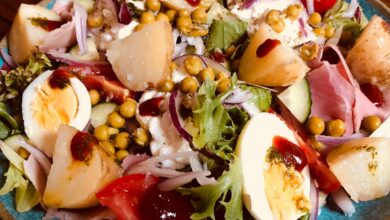Brisket Recipe
brisket

Brisket Recipe is a classic and flavorful cut of meat that is perfect for slow cooking. This recipe will guide you through the process of preparing a mouthwatering brisket that is tender, juicy, and packed with delicious flavors. Whether you’re hosting a gathering with friends and family or simply craving a comforting meal, this recipe is sure to impress. So let’s roll up our sleeves and get ready to create a memorable brisket dish that will have everyone coming back for seconds!
Brisket Recipe Overview:
This brisket recipe is all about achieving a tender and flavorful result through slow cooking. Here’s an overview of the steps involved:
Ingredient preparation: Gather the necessary ingredients, including a beef brisket, seasoning rub, aromatics, and a flavorful cooking liquid.
Seasoning the brisket: Apply a generous amount of seasoning rub to all sides of the brisket, allowing it to penetrate the meat for enhanced flavor.
Preparing the cooking environment: Preheat your oven to a low temperature or set up a slow cooker. This recipe can be adapted to either method.
Searing the brisket: Heat a large skillet or Dutch oven over high heat and sear the brisket on all sides to develop a rich, caramelized crust.
Adding aromatics and liquid: Transfer the seared brisket to your cooking vessel and add aromatics such as onions, garlic, and herbs. Pour in a flavorful liquid like beef broth or a combination of broth and barbecue sauce to enhance the taste.
Slow cooking: Cover the cooking vessel and let the brisket cook on low heat for several hours. The low and slow cooking method allows the meat to become tender and infuses it with the flavors of the seasonings and cooking liquid.
Checking for doneness: After a few hours, check the brisket for tenderness by inserting a fork or meat thermometer. It should be fork-tender or reach an internal temperature of around 195-205°F (90-96°C).
Resting and slicing: Once the brisket is cooked to perfection, remove it from the cooking vessel and let it rest for a few minutes. This allows the juices to redistribute throughout the meat. Slice the brisket against the grain to ensure tender slices.
Serving and enjoying: Serve the sliced brisket with your favorite sides, such as mashed potatoes, coleslaw, or cornbread. Drizzle some of the cooking liquid or barbecue sauce over the slices for added moisture and flavor.
Remember, cooking times may vary based on the size of your brisket and the cooking method used. It’s important to be patient and let the slow cooking process work its magic. So get ready to savor every tender and flavorful bite of this delectable brisket!

Brisket Recipe Ingredients:
Certainly! Here are the ingredients you’ll need for this brisket recipe:
1 whole beef brisket (approximately 4-6 pounds)
2 tablespoons kosher salt
2 tablespoons paprika
1 tablespoon black pepper
1 tablespoon garlic powder
1 tablespoon onion powder
1 tablespoon brown sugar
1 teaspoon cayenne pepper (adjust according to your spice preference)
2 tablespoons vegetable oil (for searing)
1 large onion, sliced
4 cloves garlic, minced
2 cups beef broth (or a combination of broth and barbecue sauce for added flavor)
Optional: additional barbecue sauce for serving
Feel free to adjust the seasonings according to your taste preferences. Additionally, you can add other herbs or spices to the rub to personalize the flavors to your liking.
Make sure to have all these ingredients ready before you begin preparing your delicious brisket!
Brisket Recipe Instructions:
Certainly! Here are the instructions for preparing and cooking your brisket:
Preheat your oven to 275°F (135°C) or set up your slow cooker according to the manufacturer’s instructions.
In a small bowl, combine the kosher salt, paprika, black pepper, garlic powder, onion powder, brown sugar, and cayenne pepper. Mix well to create your seasoning rub.
Pat the brisket dry with paper towels to remove any excess moisture. This helps the rub adhere better to the meat.
Generously season all sides of the brisket with the prepared seasoning rub. Make sure to coat the entire surface evenly, pressing the rub into the meat.
Heat a large skillet or Dutch oven over high heat and add the vegetable oil. Once the oil is hot, carefully sear the brisket on all sides until a rich, caramelized crust forms. This step helps to develop deeper flavors.
Remove the seared brisket from the skillet or Dutch oven and transfer it to your cooking vessel (either a roasting pan or slow cooker).
Add the sliced onion and minced garlic to the cooking vessel around the brisket. These aromatics will enhance the flavor of the dish.
Pour the beef broth (or a combination of broth and barbecue sauce) into the cooking vessel, ensuring that the liquid comes up about halfway to the sides of the brisket. This will help keep the meat moist during cooking.
Cover the cooking vessel with a tight-fitting lid or aluminum foil to create a sealed environment.
Place the brisket in the preheated oven or set your slow cooker to low heat. Let it cook for approximately 6-8 hours in the oven or 8-10 hours in the slow cooker. The low and slow cooking process will help tenderize the brisket and infuse it with flavors.
After the recommended cooking time, check the brisket for tenderness. Insert a fork into the meat, and if it easily slides in and out or the internal temperature reaches 195-205°F (90-96°C), the brisket is done.
Once the brisket is cooked, remove it from the cooking vessel and transfer it to a cutting board. Let it rest for about 10-15 minutes to allow the juices to redistribute.
Slice the brisket against the grain into thin slices. This helps to ensure tenderness.
Serve the sliced brisket with your favorite sides and, if desired, drizzle some of the cooking liquid or barbecue sauce over the slices for added moisture and flavor.
Enjoy your homemade brisket, and savor the delicious flavors and tender texture that slow cooking brings out in this classic dish!
Brisket Recipe Variations:
Certainly! Here are a few variations you can try with this brisket recipe to add some exciting flavors:
Smoky Barbecue Brisket: Instead of using plain beef broth, substitute half of the broth with your favorite smoky barbecue sauce. This will infuse the brisket with a rich and tangy barbecue flavor.
Asian-Inspired Brisket: For an Asian twist, replace some of the seasonings with ingredients like soy sauce, ginger, and five-spice powder. Add sliced bell peppers, carrots, and snow peas to the cooking vessel for added color and flavor.
Spicy Chipotle Brisket: Add a kick to your brisket by incorporating chipotle peppers in adobo sauce to the seasoning rub. This will give the dish a smoky and spicy flavor profile. You can also add some diced tomatoes and a squeeze of lime juice to brighten the flavors.
Beer-Braised Brisket: Instead of using beef broth, substitute it with your favorite beer, such as a dark ale or stout. The beer will add depth and complexity to the cooking liquid. Consider adding some caramelized onions and fresh thyme for additional flavor.
Tex-Mex Brisket: Give your brisket a Tex-Mex flair by adding chili powder, cumin, and oregano to the seasoning rub. Add diced tomatoes, jalapeños, and a splash of lime juice to the cooking liquid. Serve the sliced brisket in warm tortillas with toppings like avocado, salsa, and sour cream.
Feel free to get creative and experiment with different spices, sauces, and ingredients to customize the flavor of your brisket. The possibilities are endless, and you can tailor the recipe to suit your taste preferences and culinary style. Enjoy the process of exploring new variations and discovering your favorite twist on this classic dish!
Brisket Recipe Presentation and Serving Suggestions:
Certainly! Here are some presentation and serving suggestions to elevate your brisket dish:
Plating: Arrange the sliced brisket on a large serving platter or individual plates. You can slightly overlap the slices to create an attractive presentation.
Garnish: Sprinkle some freshly chopped parsley or cilantro over the brisket slices for a pop of color and freshness. You can also add a few thinly sliced red onions or pickles as a garnish.
Sauce and Dips: Serve the brisket with a side of barbecue sauce, either homemade or store-bought, for guests to drizzle over their slices according to their preference. Additionally, you can offer a variety of dipping sauces such as horseradish cream, tangy mustard, or a spicy salsa to complement the flavors.
Side Dishes: Brisket pairs well with a variety of side dishes. Here are some classic options to consider:
Creamy mashed potatoes: Serve a generous scoop of creamy mashed potatoes alongside the brisket. The potatoes will soak up the flavorful juices from the meat.
Coleslaw: A refreshing and crunchy coleslaw adds a nice contrast to the rich and tender brisket. Consider a classic cabbage-based coleslaw or a tangy vinegar-based slaw.
Cornbread: Add a Southern touch by serving warm cornbread on the side. The slightly sweet and crumbly bread complements the smoky flavors of the brisket.
Roasted vegetables: Roast a medley of seasonal vegetables like carrots, Brussels sprouts, and sweet potatoes. The caramelized flavors and textures of the roasted veggies provide a delicious accompaniment to the brisket.
Bread or Rolls: If you’d like to create brisket sandwiches, provide sliced bread or soft rolls. Guests can build their own sandwiches by adding slices of brisket and their desired toppings.
Family-Style: For a more casual gathering, you can serve the brisket family-style by placing the whole cooked brisket on a cutting board in the center of the table. Provide a selection of sides and let guests help themselves to slices of brisket.
Remember to consider the preferences and dietary restrictions of your guests when planning the sides and accompaniments. With these serving suggestions, you can create a visually appealing and delicious brisket feast that everyone will enjoy. Bon appétit!
Brisket Recipe Nutritional Information:
While I don’t have access to specific nutritional information for a particular recipe, I can provide some general guidance on the nutritional aspects of a brisket dish.
Brisket is a flavorful cut of beef that is typically rich in protein and fat. The exact nutritional content can vary based on factors such as the size of the brisket, the specific cooking method used, and any added ingredients or sauces.
Here’s a general breakdown of the nutritional components found in a typical brisket dish:
Calories: A serving of brisket can range from approximately 300 to 400 calories, depending on the portion size and fat content.
Protein: Brisket is a good source of protein, with approximately 20 to 30 grams of protein per serving.
Fat: Brisket is known for its marbling, which adds flavor and tenderness but also contributes to the fat content. The fat content can vary, but it’s common for brisket to have around 15 to 25 grams of fat per serving.
Carbohydrates: Brisket itself is a low-carbohydrate food. However, the overall carbohydrate content of the meal can increase depending on the chosen sides or sauces.
It’s important to note that these values are approximate and can vary depending on the specific recipe and ingredients used. If you have specific dietary concerns or are following a particular eating plan, it’s recommended to calculate the nutritional information based on the specific ingredients and portion sizes you use in your recipe.
Remember to enjoy brisket in moderation as part of a well-balanced diet, and consider incorporating plenty of vegetables and whole grains alongside it for a nutritious and satisfying meal.
Brisket Recipe Conclusion:
Congratulations! You’ve reached the end of our brisket recipe journey. We hope this recipe has inspired you to embark on a flavorful adventure with slow-cooked brisket. By following the steps, you’ll create a tender and delicious dish that will leave your taste buds satisfied and your guests impressed.
Whether you’re hosting a special occasion or simply craving a comforting meal, brisket is a classic choice that never disappoints. The slow cooking process allows the flavors to meld together, resulting in a mouthwatering dish that is worth the wait.
Remember to personalize your brisket by trying out different variations and adding your own twist to the recipe. Play with spices, sauces, and cooking methods to create a brisket that suits your taste preferences and culinary style.
As you slice into that tender, flavorful brisket, savor the accomplishment and enjoy the company of your loved ones. Pair it with delectable sides, garnishes, and sauces to enhance the overall dining experience.
We hope this brisket recipe has brought you joy in the kitchen and delighted your palate. Happy cooking and bon appétit!





